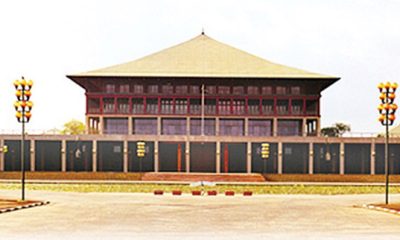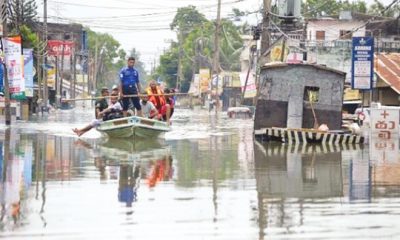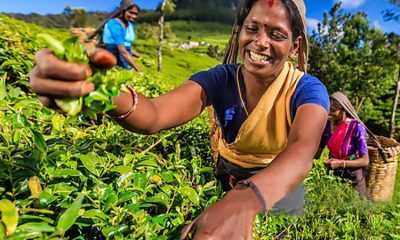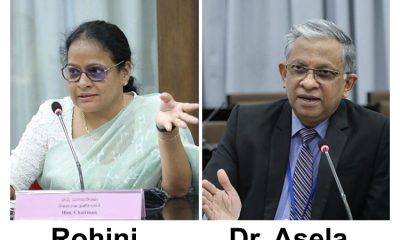Features
Dam Safety – whose responsibility?
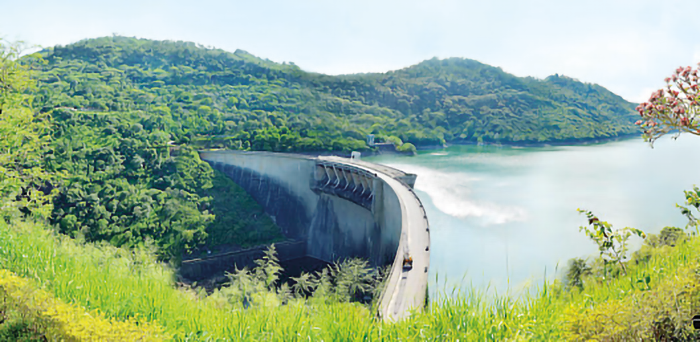
by Eng (Ms) Badra Kamaladasa
On September 10 a horrible dam disaster occurred in Libya stunning the global community with its consequences. Dam experts the world over began sharing information, opinions etc. to establish the reason for the failure. The latest figures on death or disappearance of humans are 10,000 and 11,000 rspectively. No account is available yet on other affected living species such as pets and farm animals. It would take months to estimate the damage to infrastructure and the environment. The mental scarring of those affected will not be measurable for generations, a fact noted by the scientific community.
Reuters reports that U.N. Secretary-General Antonio Guterres told the General Assembly that Derna (the disaster location) residents were “victims many times over of war, climate change and leaders – near and far – who failed to find a way to peace”. Angry residents say the disaster could have been prevented. Officials acknowledge that a contract to repair the dams after 2007 was never completed, blaming insecurity in the area for that. Engineers blame years of neglect due to political instability in the country for the failure of the two dams. By this week eight officials were jailed for negligence of their duties that caused the deadly collapse of the dams.
This whole episode reminded me of the Kantale dam breach of April 1986, more than 37 years ago. Even though the rest of the country has forgotten that disaster which took 127 human lives, totally destroyed nearly 600 private and government-owned buildings and partly damaged another 630, and washed away roads and other infrastructure.
Area farmers lost their crops. The survivors and officials on the spot can remember the devastation and agony of the aftermath. The cost of relief work and rehabilitation of infrastructure was Rs. 525 million then, which would be more than Rs. 12 billion at today’s value.
Can anyone ensure that similar disasters will not happen in the future? Whose responsibility is it to prevent or mitigate such disasters? Let us get some idea about causes of dam disasters and responsibilities of various sectors in minimizing the risks.
A dam is considered as the most hazard prone man made structure, among all civil engineering structures. Failure of a single large dam can cause the instant loss of thousands of lives, billions worth of property damage and a priceless environment cost. Many including developed countries, have faced this horrendous experience and taken action to prevent or mitigate dam disasters.
A dam can fail with or without prior warning due to an inherited weakness, a gradually developing weakening process or as a result of a natural phenomenon such as a heavy storm, landslide or earthquake.
Hence it is difficult to design a dam with a zero probability of failure. The only solution is to have a foolproof surveillance and monitoring system in place under the direction of experienced professionals.
How vulnerable are those living in the shadow of dams is a frequently asked question. Rumours are common during bad weather about dangers of dams, particularly those located at elevations above population centers, breaching. This makes people panic and look for reliable information. One basic weakness is that people are not made aware in advance of impending danger.
Preparing inundation maps and making people aware of vulnerabilities is mandatory in many countries. In Sri Lanka, reservoirs such as Samanalawewa, Senanayake Samudraya, Nachchaduwa etc are considered high risk schemes. Proper risk analysis of each and every dam needs to be undertaken with the support of scientifically proven models now available. Investigations and detailed research may need to be done with regard to dams that may be at risk due to complex processes.
Whether a dam is made of earth, concrete or a combination of rock and core material, it is susceptible to aging, similar to a living being. It has a life span which can be extended by proper maintenance, upgrading and correct operation of associated structures. If no proper attention is paid, the dam’s life span will become less than specified. Similar to human beings, dams too should be subject to proper checks/ surveillance by specialists and remedial action taken where necessary.
Statistics show that highest number of dam failures had occurred globally due to overflow during heavy storms. Hence excess incoming water has to be released safely through the spill in a properly controlled manner.
Water released from a breach of a small village tank can be sufficient to trigger a large dam failure. This is inevitable given the topography of our river basins with dams located in close proximity to each other. In the 1957/58 floods Sri Lanka experienced such a situation when 35 large, 53 medium sized and 1,500 small dams breached during a heavy storms in the NP, NCP, CP and NWP.
Spillways in large dams were upgraded after this experience by incorporating radial gates for engineers to manage the inflow and outflow of reservoirs according to pre-determined rules without allowing the water to go its own way. This is no final solution as these gates must be maintained and even upgraded to meet the changes in climate and ecology.
With changing hydrological conditions due to climate change, it has been observed that the intensity of rainfall is increasing within shorter periods. Hence water level in reservoirs too rise very fast. The reduction in forest cover in catchments has aggravated this process. Hence adequacy of the spillways need to be periodically studied to ensure safety of dams during floods.
Prior warning systems too need tightening to ensure that signs of dam failure are quickly communicated to those at risk and evacuation centers identified. As the boy scout motto says, we must ‘be prepared.’ Dam Safety cannot be a standalone program. It must be a part of the regional development strategy in in all localities.
Apart from the dam managing organizations, other government agencies using the reservoirs for functions such as inland fishing, domestic water supply, tourism etc too have a role to play in dam safety.
Decision making during emergencies must take into account the risks to the public as well as economic, environmental, social, and cultural impacts. The technical analysis of risks associated with a dam cannot be the sole decision-making factor. All stakeholders should participate in finalizing emergency preparedness plans. Inputs on all aspects are necessary when a warning is issued. Prevention of disaster and mitigation of impact can be achieved only through such collective action.
When people use reservoirs for bathing and washing, they must restrict themselves to designated places without disturbing the bund slope or riprap. Earth bunds should not be selected for tree planting campaigns. Trees can do much harm to the integrity of a dam.
Encroachment of dam reservations and blocking the inspection paths is a very common in Sri Lanka. While it is the responsibility of the engineers to make sure dams are kept healthy, government support like funds for regular maintenance and that of other stakeholders and the public is necessary to achieve desired results.
Ultimate responsibility for a national disaster directly rests with the president/prime minister of a country whether the dam is publicly or privately-owned. This is why the president chairs the National Council for Disaster Management (NCDM), according to the Sri Lanka Disaster Management Act No. 13 of 2005.
(The writer is a retired Director General of Irrigation)
Features
US-CHINA RIVALRY: Maintaining Sri Lanka’s autonomy

During a discussion at the Regional Center for Strategic Studies (RCSS) in Sri Lanka on 9 December, Dr. Neil DeVotta, Professor at Wake Forest University, North Carolina, USA commented on the “gravity of a geopolitical contest that has already reshaped global politics and will continue to mould the future. For Sri Lanka – positioned at the heart of the Indian Ocean, economically fragile, and diplomatically exposed- his analysis was neither distant nor abstract. It was a warning of the world taking shape around us” (Ceylon Today, December 14, 2025).
Sri Lanka is known for ignoring warnings as it did with the recent cyclone or security lapses in the past that resulted in terrorist attacks. Professor De Votta’s warning too would most likely be ignored considering the unshakable adherence to Non-Alignment held by past and present experts who have walked the halls of the Foreign Ministry, notwithstanding the global reshaping taking place around us almost daily. In contrast, Professor DeVotta “argued that nonalignment is largely a historical notion. Few countries today are truly non-aligned. Most States claiming neutrality are in practice economically or militarily dependent on one of the great powers. Sri Lanka provides a clear example while it pursues the rhetoric of non-alignment, its reliance on Chinese investments for infrastructure projects has effectively been aligned to Beijing. Non-alignment today is more about perceptions than reality. He stressed that smaller nations must carefully manage perceptions while negotiating real strategic dependencies to maintain flexibility in an increasingly polarised world.” (Ibid).
The latest twist to non-alignment is Balancing. Advocates of such policies are under the delusion that the parties who are being “Balanced” are not perceptive enough to realise that what is going on in reality is that they are being used. Furthermore, if as Professor DeVotta says, it is “more about perception than reality”, would not Balancing strain friendly relationships by its hypocrisy? Instead, the hope for a country like Sri Lanka whose significance of its Strategic Location outweighs its size and uniqueness, is to demonstrate by its acts and deeds that Sri Lanka is perceived globally as being Neutral without partiality to any major powers if it is to maintain its autonomy and ensure its security.
DECLARATION OF NEUTRALITY AS A POLICY
Neutrality as a Foreign Policy was first publicly announced by President Gotabaya Rajapaksa during his acceptance speech in the holy city of Anuradhapura and later during his inauguration of the 8th Parliament on January 3, 2020. Since then Sri Lanka’s Political Establishment has accepted Neutrality as its Foreign Policy judging from statements made by former President Ranil Wickremesinghe, Prime Minister Dinesh Gunawardena and Foreign Ministers up to the present when President Dissanayake declared during his maiden speech at the UN General Assembly and captured by the Head Line of Daily Mirror of October 1, 2025: “AKD’s neutral, not nonaligned, stance at UNGA”
The front page of the Daily FT (Oct.9, 2024) carries a report titled “Sri Lanka reaffirms neutral diplomacy” The report states: “The Cabinet Spokesman and Foreign Minister Vijitha Herath yesterday assured that Sri Lanka maintains balanced diplomatic relations with all countries, reaffirming its policy of friends of all and enemy of none”. Quoting the Foreign Minister, the report states: “There is no favouritism. We do not consider any country to be special. Whether it is big or small, Sri Lanka maintains diplomatic relations with all countries – China, India, the US, Russia, Cuba, or Vietnam. We have no bias in our approach, he said…”
NEUTRALITY in OPERATION
“Those who are unaware of the full scope and dynamics of the Foreign Policy of Neutrality perceive it as being too weak and lacking in substance to serve the interests of Sri Lanka. In contrast, those who are ardent advocates of Non-Alignment do not realize that its concepts are a collection of principles formulated and adopted only by a group of like-minded States to meet perceived challenges in the context of a bi-polar world. In the absence of such a world order the principles formulated have lost their relevance” (https://island.lk/relevance-of-a neutral-foreign-policy).
“On the other hand, ICRC Publication on Neutrality is recognized Internationally “The sources of the international law of neutrality are customary international law and, for certain questions, international treaties, in particular the Paris Declaration of 1856, the 1907 Hague Convention No. V respecting the Rights and Duties of Neutral Powers and Persons in Case of War on Land, the 1907 Hague Convention No. XIII concerning the Rights and Duties of Neutral Powers in Naval War, the four 1949 Geneva Conventions and Additional Protocol I of 1977 (June 2022)” (Ibid).
“A few Key issues addressed in this Publication are: “THE PRINCIPLE OF INVOILABILITY of a Neutral State and THE DUTIES OF NEUTRAL STATES.
“In the process of reaffirming the concept of Neutrality, Foreign Minister Vijitha Herath stated that the Policy of Neutrality would operate in practice in the following manner: “There is no favoritism. We do not consider any country to be special. Whether it is big or small, Sri Lanka maintains diplomatic relations with all countries – China, India, the US, Russia, Cuba or Vietnam. We have no bias in our approach” (The Daily FT, Oct, 9, 2024).
“Essential features of Neutrality, such as inviolability of territory and to be free of the hegemony of power blocks were conveyed by former Foreign Minister Ali Sabry at a forum in Singapore when he stated: “We have always been clear that we are not interested in being an ally of any of these camps. We will be an independent country and work with everyone, but there are conditions. Our land and sea will not be used to threaten anyone else’s security concerns. We will not allow military bases to be built here. We will not be a pawn in their game. We do not want geopolitical games playing out in our neighbourhood, and affecting us. We are very interested in de-escalating tensions. What we could do is have strategic autonomy, negotiate with everyone as sovereign equals, strategically use completion to our advantage” (the daily morning, July 17, 2024)
In addition to the concepts and expectations of a Neutral State cited above, “the Principle of Inviolability of territory and formal position taken by a State as an integral part of ‘Principles and Duties of a Neutral State’ which is not participating in an armed conflict or which does not want to become involved” enabled Sri Lanka not to get involved in the recent Military exchanges between India and Pakistan.
However, there is a strong possibility for the US–China Rivalry to manifest itself engulfing India as well regarding resources in Sri Lanka’s Exclusive Economic Zone. While China has already made attempts to conduct research activities in and around Sri Lanka, objections raised by India have caused Sri Lanka to adopt measures to curtail Chinese activities presumably for the present. The report that the US and India are interested in conducting hydrographic surveys is bound to revive Chinese interests. In the light of such developments it is best that Sri Lanka conveys well in advance that its Policy of Neutrality requires Sri Lanka to prevent Exploration or Exploitation within its Exclusive Economic Zone under the principle of the Inviolability of territory by any country.
Another sphere where Sri Lanka’s Policy of Neutrality would be compromised is associated with Infrastructure Development. Such developments are invariably associated with unsolicited offers such as the reported $3.5 Billion offer for a 200,000 Barrels a day Refinery at Hambantota. Such a Project would fortify its presence at Hambantota as part of its Belt and Road Initiative. Such offers if entertained would prompt other Global Powers to submit similar proposals for other locations. Permitting such developments on grounds of “Balancing” would encourage rivalry and seriously threaten Sri Lanka’s independence to exercise its autonomy over its national interests.
What Sri Lanka should explore instead, is to adopt a fresh approach to develop the Infrastructure it needs. This is to first identify the Infrastructure projects it needs, then formulate its broad scope and then call for Expressions of Interest globally and Finance it with Part of the Remittances that Sri Lanka receives annually from its own citizens. In fact, considering the unabated debt that Sri Lanka is in, it is time that Sri Lanka sets up a Development Fund specifically to implement Infrastructure Projects by syphoning part of the Foreign Remittances it receives annually from its citizens . Such an approach means that it would enable Sri Lanka to exercise its autonomy free of debt.
CONCLUSION
The adherents of Non-Alignment as Sri Lanka’s Foreign Policy would not have been pleased to hear Dr. DeVotta argue that “non-alignment is largely a historical notion” during his presentation at the Regional Center for Strategic Studies in Colombo. What is encouraging though is that, despite such “historical notions”, the political establishment, starting with President Gotabaya Rajapaksa and other Presidents, Prime Ministers and Ministers of Foreign Affairs extending up to President AKD at the UNGA and Foreign Affairs Minister, Vijitha Herath, have accepted and endorsed neutrality as its foreign policy. However, this lack of congruence between the experts, some of whom are associated with Government institutions, and the Political Establishment, is detrimental to Sri Lanka’s interests.
If as Professor DeVotta warns, the future Global Order would be fashioned by US – China Rivalry, Sri Lanka has to prepare itself if it is not to become a victim of this escalating Rivalry. Since this Rivalry would engulf India a well when it comes to Sri Lanka’s Exclusive Economic Zone (EEC), Sri Lanka should declare well in advance that no Exploration or Exploitation would be permitted within its EEC on the principle of inviolability of territory under provisions of Neutrality and the UN adoption of the Indian Ocean as a Zone of Peace.
As a measure of preparedness serious consideration should be given to the recommendation cited above which is to set up a development fund by allocating part of the annual dollar remittances to finance Sri Lanka’s development without depending on foreign direct investments, export-driven strategies or the need to be flexible to negotiate dependencies; A strategy that is in keeping with Sri Lanka’s civilisational values of self-reliance. Judging from the unprecedented devastation recently experienced by Sri Lanka due to lack of preparedness and unheeded warnings, the lesson for the political establishment is to rely on the wisdom and relevance of Self-Reliance to equip Sri Lanka to face the consequences of the US–China rivalry.
by Neville Ladduwahetty ✍️
Features
1132nd RO Water purification plant opened at Mahinda MV, Kauduluwewa

A project sponsored by Perera and Sons (P&S) Company and built by Sri Lanka Navy
Petroleum Terminals Ltd
Former Managing Director Ceylon Petroleum Corporation
Former High Commissioner to Pakistan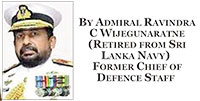
When the 1132nd RO plant built by the Navy with funds generously provided by M/S Perera and Sons, Sri Lanka’s iconic, century-old bakery and food service chain, established in 1902, known for its network of outlets, numbering 235, in Sri Lanka. This company, established in 1902 by Philanthropist K. A. Charles Perera, well known for their efforts to help the needy and humble people. Helping people gain access to drinking water is a project launched with the help of this esteemed company.
The Chronic Kidney Disease (CKD) started spreading like a wildfire mainly in North Central, North Western and Eastern provinces. Medical experts are of the view that the main cause of the disease is the use of unsafe water for drinking and cooking. The map shows how the CKD is spreading in Sri Lanka.
In 2015, when I was the Commander of the Navy, with our Research and Development Unit of SLN led by a brilliant Marine Engineer who with his expertise and innovative skills brought LTTE Sea Tigers Wing to their knees. The famous remote-controlled explosive-laden Arrow boats to fight LTTE SEA TIGER SUCIDE BOATS menace was his innovation!). Then Captain MCP Dissanayake (2015), came up with the idea of manufacturing low- cost Reverse Osmosis Water Purification Plants. The SLN Research and development team manufactured those plants at a cost of one-tenth of an imported plant.

Gaurawa Sasthrawedi Panditha Venerable Devahuwe Wimaladhamma TheroP/Saraswathi Devi Primary School, Ashokarama Maha Viharaya, Navanagara, Medirigiriya
The Navy established FIRST such plant at Kadawatha-Rambawa in Madawachiya Divisional Secretariat area, where the CKD patients were the highest. The Plant was opened on 09 December 2015, on the 65th Anniversary of SLN. It was an extremely proud achievement by SLN
First, the plants were sponsored by officers and sailors of the Sri Lanka Navy, from a Social Responsibility Fund established, with officers and sailors contributing Rs 30 each from their salaries every month. This money Rs 30 X 50,000 Naval personnel provided us sufficient funds to build one plant every month.
Observing great work done by SLN, then President Maithripala Sirisena established a Presidential Task Force on eradicating CKD and funding was no issue to the SLN. We developed a factory line at our R and D unit at Welisara and established RO plants at double-quick time. Various companies/ organisations and individuals also funded the project. Project has been on for the last ten years under six Navy Commanders after me, namely Admiral Travis Sinniah, Admiral Sirimevan Ranasinghe, Admiral Piyal de Silva, Admiral Nishantha Ulugetenna, Admiral Priyantha Perera and present Navy Commander Vice Admiral Kanchana Banagoda.
Each plant is capable of producing up to 10,000 litres of clean drinking water a day. This means a staggering 11.32 million litres of clean drinking water every day!
The map indicates the locations of these 1132 plants.
Well done, Navy!
On the occasion of its 75th Anniversary celebrations, which fell on 09 December 2025, the Navy received the biggest honour. Venerable Thero (Venerable Dewahuwe Wimalarathana Thero, Principal of Saraswathi Devi Primary Pirivena in Medirigiriya) who delivered the sermons during opening of 1132nd RO plant, said, “Ten years ago, out of 100 funerals I attended; more than 80 were of those who died of CKD! Today, thanks to the RO plants established by the Navy, including one at my temple also, hardly any death happens in our village due to CKD! Could there be a greater honour?
Features
Poltergeist of Universities Act

 The Universities Act is back in the news – this time with the present government’s attempt to reform it through a proposed amendment (November 2025) presented by the Minister of Education, Higher Education and Vocational Education, Harini Amarasuriya, who herself is a former academic and trade unionist. The first reading of the proposed amendment has already taken place with little debate and without much attention either from the public or the university community. By all counts, the parliament and powers across political divisions seem nonchalant about the relative silence in which this amendment is making its way through the process, indicative of how low higher education has fallen among its stakeholders.
The Universities Act is back in the news – this time with the present government’s attempt to reform it through a proposed amendment (November 2025) presented by the Minister of Education, Higher Education and Vocational Education, Harini Amarasuriya, who herself is a former academic and trade unionist. The first reading of the proposed amendment has already taken place with little debate and without much attention either from the public or the university community. By all counts, the parliament and powers across political divisions seem nonchalant about the relative silence in which this amendment is making its way through the process, indicative of how low higher education has fallen among its stakeholders.
The Universities Act No. 16 of 1978 under which Sri Lankan universities are managed has generated debate, though not always loud, ever since its empowerment. Increasing politicisation of decision making in and about universities due to the deterioration of the conduct of the University Grants Commission (UGC) has been a central concern of those within the university system and without. This politicisation has been particularly acute in recent decades either as a direct result of some of the provisions in the Universities Act or the problematic interpretation of these. There has never been any doubt that the Act needs serious reform – if not a complete overhaul – to make universities more open, reflective, and productive spaces while also becoming the conscience of the nation rather than timid wastelands typified by the state of some universities and some programs.
But given the Minister’s background in what is often called progressive politics in Sri Lanka, why are many colleagues in the university system, including her own former colleagues and friends, so agitated by the present proposed amendment? The anxiety expressed by academics stem from two sources. The first concern is the presentation of the proposed amendment to parliament with no prior consultative process with academics or representative bodies on its content, and the possible urgency with which it will get pushed through parliament (if a second reading takes place as per the regular procedure) in the midst of a national crisis. The second is the content itself.
Appointment of Deans
Let me take the second point first. When it comes to the selection of deans, the existing Act states that a dean will be selected from among a faculty’s own who are heads of department. The provision was crafted this way based on the logic that a serving head of department would have administrative experience and connections that would help run a faculty in an efficient manner. Irrespective of how this worked in practice, the idea behind has merit.
By contrast, the proposed amendment suggests that a dean will be elected by the faculty from among its senior professors, professors, associate professors and senior lecturers (Grade I). In other words, a person no longer needs to be a head of department to be considered for election as a dean. While in a sense, this marks a more democratised approach to the selection, it also allows people lacking in experience to be elected by manoeuvring the electoral process within faculties.
In the existing Act, this appointment is made by the vice chancellor once a dean is elected by a given faculty. In the proposed amendment, this responsibility will shift to the university’s governing council. In the existing Act, if a dean is indisposed for a number of reasons, the vice chancellor can appoint an existing head of department to act for the necessary period of time, following on the logic outlined earlier. The new amendment would empower the vice chancellor to appoint another senior professor, professor, associate professor or senior lecturer (Grade I) from the concerned faculty in an acting capacity. Again, this appears to be a positive development.
Appointing Heads of Department
Under the current Act heads of department have been appointed from among professors, associate professors, senior lecturers or lecturers appointed by the Council upon the recommendation of the vice chancellor. The proposed amendment states the head of department should be a senior professor appointed by the Council upon the recommendation of the vice chancellor, and in the absence of a senior professor, other members of the department are to be considered. In the proposed scheme, a head of department can be removed by the Council. According to the existing Act, an acting head of department appointment can be made by the vice chancellor, while the proposed amendment shifts this responsibility to the Council, based upon the recommendation of the vice chancellor.
The amendment further states that no person should be appointed as the head of the same department for more than one term unless all other eligible people have already completed their responsibilities as heads of department. This is actually a positive development given that some individuals have managed to hang on to the head of department post for years, thereby depriving opportunities to other competent colleagues to serve in the post.
Process of amending the Universities Act
The question is, if some of the contents of the proposed amendment are positive developments, as they appear to be, why are academics anxious about its passing in parliament? This brings me to my first point, that is the way in which this amendment is being rushed through by the government. This has been clearly articulated by the Arts Faculty Teachers Association of University of Colombo. In a letter to the Minister of Education dated 9 December 2025, the Association makes two points, which have merit. First, “the bill has been drafted and tabled in Parliament for first reading without a consultative process with academics in state universities, who are this bill’s main stakeholders. We note that while the academic community may agree with its contents, the process is flawed because it is undemocratic and not transparent. There has not been adequate time for deliberation and discussion of details that may make the amendment stronger, especially in the face of the disaster situation of the country.”
Second, “AFTA’s membership also questions the urgency with which the bill is tabled in Parliament, and the subsequent unethical conduct of the UGC in requesting the postponement of dean selections and heads of department appointments in state universities in expectation of the bill’s passing in Parliament.”
These are serious concerns. No one would question the fact that the Universities Act needs to be amended. However, this must necessarily be based on a comprehensive review process. The haste to change only sections pertaining to the selection of deans and heads of department is strange, to say the least, and that too in the midst of dealing with the worst natural calamity the country has faced in living memory. To compound matters, the process also has been fast-tracked thereby compromising on the time made available to academics to make their views be known.
Similarly, the issuing of a letter by the UGC freezing all appointments of deans and heads of department, even though elections and other formalities have been carried out, is a telling instance of the government’s problematic haste and patently undemocratic process. Notably, this action comes from a government whose members, including the Education Minister herself, have stood steadfastly for sensible university reforms, before coming to power. The present process is manoeuvred in such a manner, that the proposed amendment would soon become law in the way the government requires, including all future appointments being made under this new law. Hence, the attempt to halt appointments, which were already in the pipeline, in the interim period.
It is evident that rather than undertake serious university sector reforms, the government is aiming to control universities and thereby their further politicization amenable to the present dispensation. The ostensible democratis0…..ation of the qualified pool of applicants for deanships opens up the possibilities for people lacking experience, but are proximate to the present powers that be, to hold influential positions within the university. The transfer of appointing powers to the Councils indicates the same trend. After all, Councils are partly made up of outsiders to the university, and such individuals, without exception, are political appointees. The likelihood of them adhering to the interests of the government would be very similar to the manner in which some vice chancellors appointed by the President of the country feel obligated to act.
All things considered, particularly the rushed and non-transparent process adopted thus far by the government does not show sincerity towards genuine and much needed university sector reforms. By contrast, it shows a crude intent to control universities at any cost. It is extremely regrettable that the universities in general have not taken a more proactive and principled position towards the content and the process of the proposed amendment. As I have said many times before, whatever ills that have befallen universities so far is the disastrous fallout of compromises of those within made for personal gain and greed, or the abject silence and disinterest of those within. These culprits have abandoned broader institutional development. This appears to be yet another instance of that sad process.
In this context, I have admiration for my former colleagues in the Faculty of Arts at the University of Colombo for having the ethical courage to indicate clearly the fault lines of the proposed amendment and the problems of its process. What they have asked is a postponement of the process giving them time to engage. In this context, it is indeed disappointing to see the needlessly conciliatory tone of the letter to the Education Minister by the Federation of University Teachers Association dated December 5, 2025, which sends the wrong signal.
If this government still believes it is a people’s government, the least it can do is give these academics time to engage with the proposed amendment. After all, many within the academic community helped bring the government to power. If not and if this amendment is rushed through parliament in needless haste, it will create a precedent that signals the way in which the government intends to do business in the future, abusing its parliamentary majority and denting its credibility for good.
-

 Midweek Review4 days ago
Midweek Review4 days agoHow massive Akuregoda defence complex was built with proceeds from sale of Galle Face land to Shangri-La
-

 Features7 days ago
Features7 days agoWhy Sri Lanka Still Has No Doppler Radar – and Who Should Be Held Accountable
-

 News3 days ago
News3 days agoPakistan hands over 200 tonnes of humanitarian aid to Lanka
-

 News3 days ago
News3 days agoPope fires broadside: ‘The Holy See won’t be a silent bystander to the grave disparities, injustices, and fundamental human rights violations’
-

 Latest News6 days ago
Latest News6 days agoLandslide early warnings in force in the Districts of Badulla, Kandy, Kegalle, Kurunegala, Matale, Nuwara Eliya and Ratnapura
-
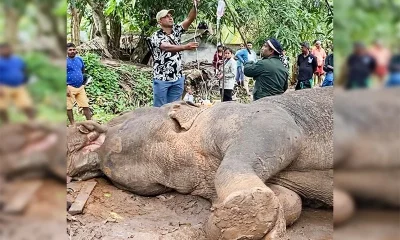
 News4 days ago
News4 days agoBurnt elephant dies after delayed rescue; activists demand arrests
-
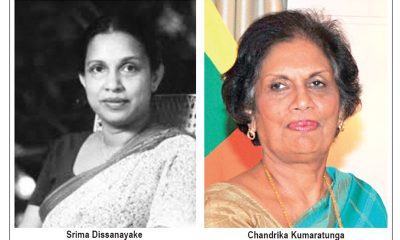
 Features7 days ago
Features7 days agoSrima Dissanayake runs for president and I get sidelined in the UNP
-

 Editorial7 days ago
Editorial7 days agoDisaster relief and shocking allegations




